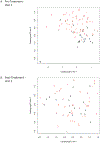Adjunctive dental therapies in caries-active children: Shifting the cariogenic salivary microbiome from dysbiosis towards non-cariogenic health
- PMID: 34485763
- PMCID: PMC8415465
- DOI: 10.1016/j.humic.2020.100077
Adjunctive dental therapies in caries-active children: Shifting the cariogenic salivary microbiome from dysbiosis towards non-cariogenic health
Abstract
Background: The oral microbiome is a complex assembly of microbial species, whose constituents can tilt the balance towards progression of oral disease or sustained health. Recently we identified sex-specific differences in the salivary microbiome contained within caries-active and caries-free children. In this study, we sought to ascertain if adjunctive dental therapies, including povidone iodine and chlorhexidine, were effective in shifting the cariogenic microbiome from dysbiosis to non-cariogenic health.
Design: We recruited young children (ages 2-12 years) to enter five enrollment groups, with each group (N = 9-30 participants/group) receiving caries restorative and/or adjunctive therapies, either singularly or in combination (OHSU IRB #6535). Saliva specimens were collected pre- and post-treatment (4-8 weeks) of caries preventive measures, and oral microbiota were identified using next generation sequencing (HOMINGS, Forsyth Institute, Cambridge, MA).
Results: With the use of multi-dimensional scaling plots, support vector machine learning, odds ratio analysis, and other statistical methods, we have determined that treatment with povidone iodine can shift the composition of the salivary cariogenic microbiome to include higher proportions of aerobic microorganisms, such as Stentrophomonas maltophila, as well as non-cariogenic, anaerobic microorganisms including Poryphyromonas and Fusobacterium species.
Conclusion: We have identified microorganisms that are associated with caries-active children and have determined that povidone iodine is an effective adjunctive therapy that has the potential to shift the composition of the cariogenic microbiome to one more closely aligned with non-cariogenic health.
Keywords: Caries-active children; Dental caries; Dysbiosis; Microbiome shift; Oral health; Povidone iodine; Salivary microbiome; Stentrophomonas maltophila.
Conflict of interest statement
Declaration of Competing Interest The authors declare that they have no known competing financial interests or personal relationships that could have appeared to influence the work reported in this paper.
Figures


Similar articles
-
Sex-specific differences in the salivary microbiome of caries-active children.J Oral Microbiol. 2019 Aug 28;11(1):1653124. doi: 10.1080/20002297.2019.1653124. eCollection 2019. J Oral Microbiol. 2019. PMID: 31497256 Free PMC article.
-
Rebalancing the Caries Microbiome Dysbiosis: Targeted Treatment and Sugar Alcohols.Adv Dent Res. 2018 Feb;29(1):110-116. doi: 10.1177/0022034517736498. Adv Dent Res. 2018. PMID: 29355418 Free PMC article. Review.
-
The Caries Microbiome: Implications for Reversing Dysbiosis.Adv Dent Res. 2018 Feb;29(1):78-85. doi: 10.1177/0022034517736496. Adv Dent Res. 2018. PMID: 29355414 Review.
-
The impact of caries status on supragingival plaque and salivary microbiome in children with mixed dentition: a cross-sectional survey.BMC Oral Health. 2021 Jun 25;21(1):319. doi: 10.1186/s12903-021-01683-0. BMC Oral Health. 2021. PMID: 34172026 Free PMC article.
-
ARE CARIOGENIC BACTERIA THE MAJOR RISK FACTOR TO DENTAL CARIES IN PATIENTS WITH ULCERATIVE COLITIS?Arq Gastroenterol. 2019 Aug 13;56(2):118-123. doi: 10.1590/S0004-2803.201900000-25. Arq Gastroenterol. 2019. PMID: 31460573
Cited by
-
Machine learning: a powerful tool for identifying key microbial agents associated with specific cancer types.PeerJ. 2023 Oct 23;11:e16304. doi: 10.7717/peerj.16304. eCollection 2023. PeerJ. 2023. PMID: 37901464 Free PMC article. Review.
-
Microbiome Changes in Children Treated under General Anesthesia for Severe Early Childhood Caries: Pilot Study.Children (Basel). 2022 Dec 24;10(1):30. doi: 10.3390/children10010030. Children (Basel). 2022. PMID: 36670581 Free PMC article.
References
Grants and funding
LinkOut - more resources
Full Text Sources
